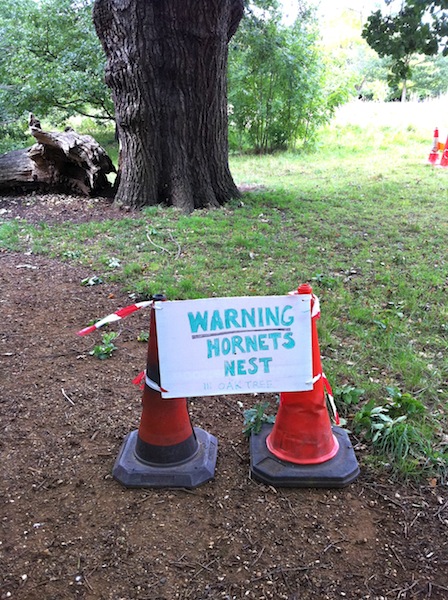About three weeks ago, I was in the garden and I saw a largeish brown and yellow insect fly past which I thought looked like the right general size, shape and colours for a hornet… but I thought that couldn’t possibly be right, and it must be some kind of hornet mimic — a large hoverfly species, or (more excitingly) a hornet moth or one of the bee hawkmoths. But I almost immediately lost track of it.
And then, ten days ago I was in the local park, standing on the little walkway over the lake looking for dragonflies, and again I saw an insect-that-looked-surprisingly-hornety, and again it didn’t wait around for to get a good look at it. So you can imagine how pleased I was a hundred yards later when I came upon this sign:

I should probably explain at this point, for all you norteamericanos, that I don’t mean something like your bald-faced hornet, which looks like an attractive little beasty but still a fairly typical wasp. No, I mean the one-and-only original, authentic, European hornet. Vespa Crabro. They say: seven stings to kill a horse, three to kill a man and two to kill a child.
This catchy little bit of folk-wisdom turns out to be rubbish, as a lot of folk wisdom does; apparently it’s only a bit more painful than any other wasp sting. But it captures something of the mystique around the hornet. It is, in the end, just a wasp, but it’s a very large wasp; it’s about twice the length of other British social wasp species, a great big bulky brown and yellow thing.
The reason I was so surprised to see them in south London was that I was under the impression that they were uncommon to rare in this country, and certainly unlikely to turn up in suburbia. But increasingly as you get older you find yourself wrong about things not because you learnt them wrong in the first place, or because you misremember them, but because the facts changed when you weren’t paying attention. And apparently hornets, which in the 60s were largely confined to the New Forest, have been spreading gradually for some time and particularly rapidly in the past ten years.
Who knows, maybe it’s global warming; but even if they are a portent of doom, they’re still a great insect and a very pleasing addition to my garden list.
And, fyi, I’m going to France tomorrow. Just for a week. So I probably won’t be posting, although I suppose if the place we’re staying has wifi I might blog from my phone.